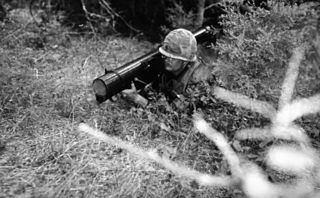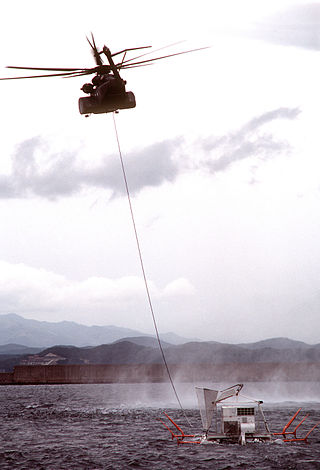
Reactive armour is a type of vehicle armour used in protecting vehicles, especially modern tanks, against shaped charges and hardened kinetic energy penetrators. The most common type is explosive reactive armour (ERA), but variants include self-limiting explosive reactive armour (SLERA), non-energetic reactive armour (NERA), non-explosive reactive armour (NxRA), and electric armour. NERA and NxRA modules can withstand multiple hits, unlike ERA and SLERA.

Armour-piercing ammunition (AP) is a type of projectile designed to penetrate armour protection, most often including naval armour, body armour, and vehicle armour.

A high-explosive squash head (HESH), in British terminology, or a high-explosive plastic/plasticized (HEP), in American terminology, is a type of explosive projectile with plastic explosive that conforms to the surface of a target before detonating, which improves the transfer of explosive energy to the target. Squash head projectiles are similar to high-explosive projectiles and are well suited to many of the same targets. However, while HESH projectiles are not armour-piercing, they can defeat armored targets by causing spall, which can injure or kill a vehicle's occupants or detonate some types of ammunition.

A shell, in a military context, is a projectile whose payload contains an explosive, incendiary, or other chemical filling. Originally it was called a bombshell, but "shell" has come to be unambiguous in a military context. A shell can hold a tracer.

In anti-tank warfare, an anti-tank mine is a type of land mine designed to damage or destroy vehicles including tanks and armored fighting vehicles.

The LAW 80, regularly referred to as LAW 94 in British service, is a man-portable, disposable anti-tank weapon previously used by the British Army and a few other militaries.

Minesweeping is the practice of removing explosive naval mines, usually by a specially designed ship called a minesweeper using various measures to either capture or detonate the mines, but sometimes also with an aircraft made for that purpose. Minesweeping has been practiced since the advent of naval mining in 1855 during the Crimean War. The first minesweepers date to that war and consisted of British rowboats trailing grapnels to snag the mines.

The TM-83 is a Soviet off-route anti-tank mine with a shaped charge, developed in 1983, and first shown publicly in 1993. The mine utilises the Misznay Schardin effect to create an armour-penetrating projectile, and is activated using its infrared and seismic sensors.

The AT2 mine is a scatterable anti-tank mine developed by Dynamit Nobel. It can be scattered from artillery rockets or from mine laying systems, and is in service with the British, German and Norwegian armed forces. AT2 mines were donated to Ukraine by Germany.
The Hohl-Sprung Mine 4672 or Hohlladungs-Spring-Mine 4672 was a German anti-tank mine, together with the Panzer stab 43. Developed during the Second World War it was the first landmine to combine a shaped charge anti-tank warhead with a tilt rod fuze.
The Adrushy is an Indian glass-reinforced, plastic-cased anti-tank landmine.
ARGES, ACEATM or MACPED is an anti-tank off-route mine, developed by an international consortium to meet the needs of the British, French and German armed forces. The system consists of a rocket and launch tube, a tripod and a sensor package.
The 4AHM-100, AHM-200, AHM-200-1, AHM-200-2, PMN-150, and PMN-250 are Bulgarian directional fragmentation mines that can be used with proximity fuzes to function as anti-helicopter mines.

The FFV 028 is a series of steel cased Swedish anti-tank mines that use electronic fuzes. The mines are circular, with a large Misznay Schardin effect warhead in the center of the mine, with the fuzing and sensor electronics located in the dead space above the main charge. The design of the mine dates from the 1970s and uses a magnetic influence sensor to detonate the mine, making it able to attack the full width of armoured vehicles.
The HAK-1 is a Hungarian plastic encased anti-tank mine. It uses a Misznay Schardin effect warhead combined with an electronic acoustic and magnetic influence fuze. The mine can be programmed for an active life of between three hours and 150 days. Once the acoustic sensor detects a target, the magnetic influence sensor is used to detonate the mine at the optimal point. The warhead is capable of penetrating 45 mm of armour and producing a 130 mm diameter hole.

The HPD-1, HPD-2 and HPD-3 are a series of French electrically fuzed anti-tank landmines of TDA Armements that use Misnay–Schardin effect warheads. The entire series of mines conform to the United States MIL-STD-331.
The Korean Smart Top-Attack Munition (KSTAM) is a smart munition intended to be launched from the gun of a main battle tank, namely the South Korean K2 Black Panther. Comparable systems include Diehl Corporation's Spear, DRDO SAMHO, CMI Defence and Luch Falarick 120, Israeli Aerospace Industries LAHAT, Nexter Systems Polynege, Alliant Techsystems STAFF and MRM-KE, Raytheon Technologies MRM-CE, and the two final companies' TERM.

Selectable Lightweight Attack Munition or is a small United States multi-purpose landmine produced by ATK Precision Fuze Company in Janesville, Wisconsin from 1992 to 2002. It has a passive infrared sensor, and a magnetic influence sensor which allow it to be used as a demolition munition, off-route mine, or full width belly attack mine.

The MSM MK2 is a Finnish belly attack anti-tank mine. The mine has a circular ribbed plastic case that is tapered towards the bottom. It uses an electronic fuze with a combination magnetic and seismic fuze; it also has an anti-handling device. The mine is armed by inserting an arming pin, which completes an electronic circuit. The mine indicates that it is armed by lighting a small LED light which switches off after 10 minutes. When a vehicle approaches, vibrations travelling through the ground trigger the seismic sensor, which activates the magnetic sensor. When a vehicle passes over the mine, the warhead is triggered. First a clearing charge fire, removing up to 100 millimeters of earth from the top of the mine, then a copper-lined Misznay Schardin effect warhead is triggered. This projects a slug of copper at high velocity into the bottom of the target.
In military munitions, a fuze is the part of the device that initiates its function. In some applications, such as torpedoes, a fuze may be identified by function as the exploder. The relative complexity of even the earliest fuze designs can be seen in cutaway diagrams.













